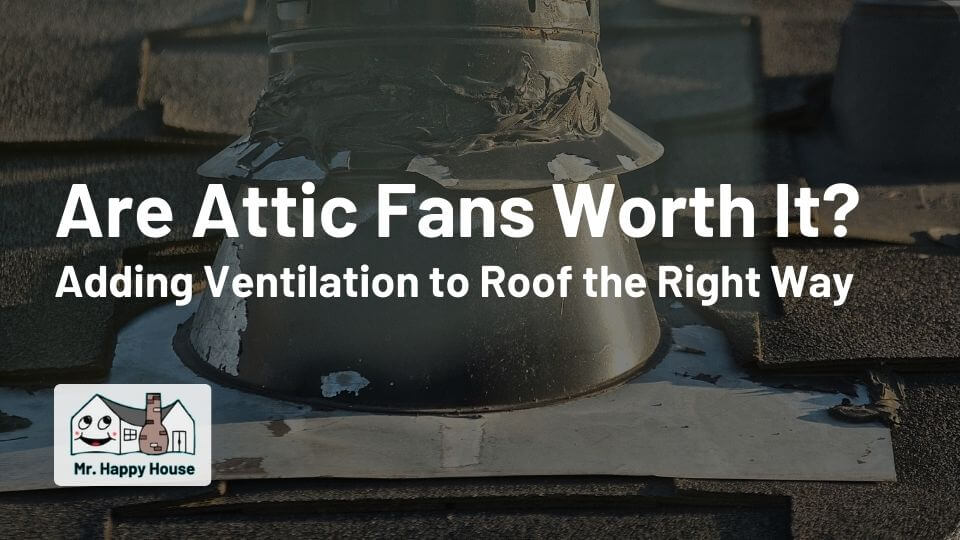
Best GAF Certified Roofers in The Woodlands, TX – Quality Roof Replacement, Gutters & Siding
Best GAF Certified Roofers in The Woodlands, TX – Quality Roof Replacement, Gutters & Siding Best GAF Certified Roofers in The Woodlands, TX – Quality

Attic fans, also known as attic ventilators, play a crucial role in maintaining the temperature in your attic and your home, and for hot climates, it’s extremely critical in order for your roof to not grow mold.
Attic fans/vents are designed to regulate the heat buildup in the attic space, thereby impacting the overall temperature of the house. This article aims to explore the effectiveness and worth of attic fans in improving the ventilation of a roof.
By diving into their functionality, advantages, and potential drawbacks, you will be better informed in making the right decisions regarding the installation of attic fans for better home climate control.
Effective roof ventilation is fundamental for maintaining a healthy and functional home environment. The attic, being a space directly beneath the roof, is particularly prone to temperature fluctuations. Without proper ventilation, the attic can trap excess heat, leading to various issues such as moisture accumulation, which can foster mold growth, and increased energy costs due to the strain on cooling systems.
A well-ventilated roof aids in expelling this trapped heat, reducing the temperature within the attic and, consequently, the entire house. This process not only enhances the comfort of living spaces but also contributes to the longevity of the roof by minimizing the risks of moisture-related damage.
Understanding the significance of proper roof ventilation lays the groundwork for assessing the role that attic fans play in this context.
Like any home improvement addition, attic fans come with a set of advantages and considerations. Understanding these can help homeowners make an informed decision:
Temperature Regulation: Attic fans aid in regulating the temperature inside the attic, preventing excessive heat buildup.
Energy Efficiency: By reducing the heat in the attic, they can lower the load on air conditioning systems, potentially decreasing energy costs.
Moisture Control: Effective ventilation helps prevent moisture buildup, reducing the risk of mold and damage to the structure.
Enhanced Comfort: A well-ventilated home tends to offer more consistent and comfortable indoor temperatures.
Installation Costs: The initial investment and installation of attic fans can add to the overall cost.
Maintenance Needs: Like any mechanical system, attic fans require periodic maintenance, which could be an added responsibility for homeowners.
Noise: Some attic fans can generate noise, which might be a concern for those sensitive to sound.
Understanding these advantages and potential drawbacks is crucial when considering the installation of attic fans for roof ventilation.
Attic fans come in various types, each with its unique features and mechanisms. Understanding the differences between these types can help in choosing the most suitable option for specific needs:
Choosing the right type of attic fan involves considering factors like the attic’s size, the climate in the region, energy preferences, and installation feasibility.
Installing an attic fan typically involves several key steps:
Professional installation by a roofer such as Mr. Happy House is often recommended to ensure safety and proper functioning of the attic fan/vent. Following manufacturer instructions is crucial to ensure the fan operates effectively and efficiently.
The performance of attic fans varies based on factors such as size, type, and installation. When properly installed and suited to the attic’s needs, these fans can offer several benefits:
Temperature Regulation: Attic fans excel in reducing heat buildup, keeping the attic space cooler and consequently lowering the overall temperature of the house.
Energy Savings: By reducing the workload on air conditioning systems, attic fans can potentially lower energy consumption and costs, particularly during hot seasons.
Moisture Control: Effective ventilation prevents moisture accumulation, reducing the risks of mold growth and structural damage.
Improved Air Quality: Constant air circulation facilitated by attic fans helps maintain better indoor air quality.
However, the efficiency of attic fans can be influenced by various factors, including the climate, the size of the attic, and the fan’s size and capacity. In certain climates, particularly those with high humidity or cooler temperatures, the benefits of attic fans might be less pronounced.
Additionally, improper installation, undersized fans, or inadequate venting in the attic can hamper the overall efficiency. It’s crucial to consider these factors to maximize the effectiveness of attic fans.
Attic fans, like any mechanical system, require regular maintenance to ensure optimal performance and longevity. Key aspects of maintenance include:
Regular upkeep not only ensures efficiency but also prevents premature breakdowns, thereby maximizing the investment in attic ventilation.
Before committing to the installation of attic fans, consider the following factors:
Considering these factors helps in making a more informed decision, ensuring the attic fan aligns with the specific needs and conditions of the home.
While it is important to have roof attic ventilation in order for hot air to escape your attic to keep your roof cool during the summer, it’s also a crucial component in making sure your roof stays intact. Without proper roof attic ventilation, your roof can be at risk of growing mold, which that alone can cause significant damage if left unresolved.
In the YouTube video above (at the beginning of the article), we have discussed the best solution for adding air circulation to the roof.
Our Services:












Schedule an Estimate Today!

Best GAF Certified Roofers in The Woodlands, TX – Quality Roof Replacement, Gutters & Siding
Best GAF Certified Roofers in The Woodlands, TX – Quality Roof Replacement, Gutters & Siding Best GAF Certified Roofers in The Woodlands, TX – Quality

Are Gutters Part of the Roofing System?
Are Gutters Part of the Roofing System? Are Gutters Part of the Roofing System? When it comes to home maintenance, gutters often seem like a

Why James Hardie is The Best Option for Home Siding
Why James Hardie is The Best Option for Home Siding Why James Hardie is The Best Option for Home Siding James Hardie stands out whether











